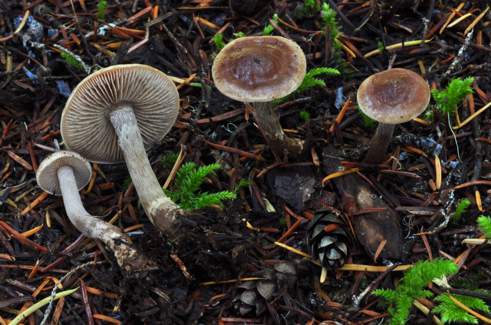 Hebeloma praeolidum (Photo: N. Siegel)
Hebeloma praeolidum (Photo: N. Siegel)Taxonomy
Full name: Hebeloma praeolidum A.H. Sm., V.S. Evenson & Mitchel, The Veiled Species of Hebeloma in the Western United States: 89 (1983)Genus: Hebeloma
Section: Hebeloma
Subsection: 'subsect1'
Types: UNITED STATES: Washington: Olympic Hot Springs, Olympic National Park, Clallam County (approx. 47.9763°N, 123.6842°W, alt. approx. 670 m a.s.l.) on mossy soil, 22 Aug. 1941, A.H. Smith (17169) (Holotype. herbarium acc. no. MICH 10791, HJB1000466).
Heterotypic synonyms:
- Hebeloma boulderense A.H. Sm., V.S. Evenson & Mitchel, The Veiled Species of Hebeloma in the Western United States: 93 (1983)
- Hebeloma cinereostipes A.H. Sm., V.S. Evenson & Mitchel, The Veiled Species of Hebeloma in the Western United States: 158 (1983)
- Hebeloma perplexum A.H. Sm., V.S. Evenson & Mitchel, The Veiled Species of Hebeloma in the Western United States: 95 (1983)
- arrow_drop_downarrow_drop_upEtymologyThe prefix ‘prae’ meaning ‘very’ and ‘olidus’, meaning ‘emitting a smell’, to emphasise the odour, which the authors regarded as ‘heavy and sweetly armatic (sickening in time)’.
- arrow_drop_downarrow_drop_upOriginal diagnosisPileus (1.5) 2-4 (6) cm latus, obtuse conicus demum late convexus vel umbonatus, viscidus, ad marginem fibrillosus, glabrescens; ad centrum pallide argillaceus vel luteobrunneus, ad marginem pallide griseobrunneus; odor graveolens; sapor valde subamarus (distinctissimus). Lamellae confertae, latae, luteobrunneae. Stipes 4-7 cm longus, (4) 5-7 mm crassus, deorsum brunneus, sursum pallide argillaceus. Sporae 9-12 x 5-6.5 µm, in "KOH" subleves, argillaceae. Basidia tetraspora. Cheilocystidia 36-50 x 5-8 µm, filamentosa vel ad basin + ventricosa.
- arrow_drop_downarrow_drop_upEnglish translationPileus (1.5) 2-4 (6) cm broad, obtusely conical then broadly convex or umbonate, viscid, fibrillose on the margin, becoming glabrous; pale argillaceous or yellow-brown on the disc, pale grey-brown on the margin; smell nauseating; taste strongly bitter (very peculiar). Lamellae crowded, broad, yellow-brown. Stipe 4-7 cm long, (4) 5-7 mm thick, brown towards the base, pale argillaceous upwards. Spores 9-12 x 5-6.5 μm, almost smooth in KOH, argillaceous. Basidia four-spored. Cheilocystidia 36-50 x 5-8 μm, filamentous or more or less ventricose at base.
References
Description
- arrow_drop_downarrow_drop_upThresholds
Description of Hebeloma praeolidum based on 56 collections
- arrow_drop_downarrow_drop_upMacroscopic descriptionPileus: (15) 20–46 (65) mm diameter; shape convex, occasionally broadly umbonate, rarely umbonate; characters often remains of universal veil; margin characters often smooth or involute, occasionally fibrillose; viscosity tacky when moist; colour variation usually two color, rarely unicolour; colour at centre occasionally paler, rarely yellowish brown, dark brick, brownish olive, whitish, cinnamon, umber or dark pinkish buff.
Lamellae: attachment often emarginate, occasionally adnate, rarely adnexed; maximum depth 2–6 mm; number of complete lamellae 34–60; presence of tears usually absent, rarely visible with x10 lens; white fimbriate edge often present, occasionally weak.
Cortina presence: yes.
Stipe: (18) 26–93 (120) x 3–8 (12) {median} x 3–11 (15) {basal} mm; stipe Q 3.6–20.0; base shape usually cylindrical, often clavate, rarely tapering; floccosity usually fibrillose, often pruinose at apex, rarely floccose or pruinose; rooting no; thick rhizoids at base absent;
Context: Texture firm; stipe interior usually hollow, occasionally stuffed; stipe flesh discolouring usually yes, rarely no or very strongly; slenderness measure 3.0–58.2; smell occasionally fruit, sweet, raphanoid or strongly raphanoid, rarely odourless or earthy; taste occasionally bitter, mild, none or hot where recorded.
Spore deposit colour: often brownish olive or umber.
Exsiccata characters: Not recorded.
- arrow_drop_downarrow_drop_upMicroscopic descriptionSpores: shape amygdaloid, rarely fusoid, ellipsoid or ovoid; colour in microscope often yellow brown, occasionally brown, rarely brown pale or grey yellow; guttules variable. papilla variable often weak; Spore Code: O2 (O3); P0 P1; D2 (D3).
Basidia: (20) 24–38 (39) x (4) 5–8 (9) μm; ave. Q 4.0–4.6; spore arrangement usually 4 spored, occasionally variable;
Cheilocystidia: main shape lageniform or ventricose; special features observed often septa, occasionally basal thickening or sparse, rarely many collapsed in exsiccata or branching; cheilocystidia ratios: A/M = 1.02–1.19; A/B = 0.52–0.74; B/M = 1.54–2.15.
Pleurocystidia: none seen.
Ixocutis: epicutis thickness (measured from exsiccata) up to 200 μm; ixocutis hyphae width up to 7 μm; ixocutis hyphae encrustation variable; shape of trama elements beneath subcutis often ellipsoid, occasionally cylindrical, isodiametric or thickly sausage-shaped up to 15 μm wide.
Caulocystidia: Similar to cheilocystidia but larger, up to 90 μm.
- arrow_drop_downarrow_drop_upSpore measurements
- arrow_drop_downarrow_drop_upCheilocystidia measurements
- arrow_drop_downarrow_drop_upHabitat and distributionHebeloma praeolidum's preferred habitat appears to be mixed woodland or coniferous, subalpine woodland with mossy soil or soil and litter. Where only one possible associate was recorded, the most commonly recorded associate was Picea (57.1%) but Pseudotsuga (14.3%), Abies (14.3%) and Pinus (14.3%) were also recorded. In these cases the most commonly recorded family was Pinaceae (100.0%). We have additional records where Arbutus (24.2%), Tsuga (18.2%), Quercus (15.2%), Salix (6.1%) and Alnus (3.0%) were recorded as possible associates, but in these cases a number of possible associates were mentioned. Overall the most commonly recorded families are Pinaceae (78.8%), Ericaceae (24.2%), Fagaceae (15.2%) and Salicaceae (6.1%) The growth habit of our collections was often scattered, occasionally solitary and rarely gregarious.
According to our current collections, the species is found only in Northern America. On the continent, collections have been found only in the temperate conifer forests WWF biome The World Wildlife Fund (WWF) have divided the world into 867 terrestrial ecoregions. The ecoregion here is estimated by mapping from the GPS coordinates of the collection using data made available by Dinerstein et al (2017). Use this webtool to explore the ecoregions visually or see a full list of current ecoregions on Wikipedia. (Puget lowland forests (32.7%), Central-Southern Cascades Forests (14.5%), Colorado Rockies forests (12.7%) and Central Pacific Northwest coastal forests (10.9%) ecoregions). From collector information, it appears collections have been found in the 1.4 Forest – Temperate (61.3%) and 1.1 Forest – Boreal (38.7%) IUCN habitats We map from the collector's description of the habitat to the International Union for Conservation of Nature (IUCN)'s definition using a standardised set of rules. Please see this page for a full list of IUCN habitats.. Within Northern America we have records from Northwestern U.S.A. (Washington, Colorado, Oregon and Idaho), Western Canada (British Columbia and Alberta) and Southwestern U.S.A. (California).
Geographic distribution
Phenology
- arrow_drop_downarrow_drop_upAdditional cited collections